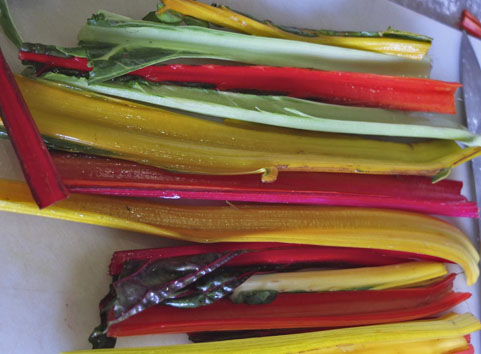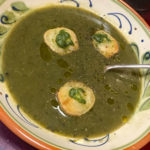Chard is very popular in Provence and can be found in the markets, almost the year round. Though similar tasting to spinach, it is unrelated and belongs to the same family as beetroot and sugar beet. It is rich in calcium and iron as well as vitemine C and B9, so very good for you! I particularly like the rainbow or ruby chard as it looks so pretty.
The secret to cooking chard, is to cook the stalks separately from the leaves, as they take longer to cook. The French typically use it for Tourte de Blette, which is a sweet tart that derives from Nice and is cooked with pine nuts, brandy and raisons. David Lebevitz has a version of it here. However, if the notion of a sweet tart is not up your alley, then a savoury tart, Tourte de Blette Salées, is the way to go.
Caroline Conran, in her book, Sud de France, has a recipe for Tarte de brousse aux blettes using goat’s curd cheese, a delicacy of the region, mixed with cream, eggs and milk. However if you don’t live near a goat farm, and are not able to readily source goat’s curd, you can substitute this with fromage frais or ricotta.
I decided to make a chard tart using cream cheese and feta and, inspired by Ottolenghi’s Sweet chard and herb tart with young cheese, topped it with courgette flowers which are readily available in the markets in France during the summer.
Chard tart with feta and courgette flowers
- Bunch of chard or 8 large leaves
- 200g cream cheese
- 200g feta cheese
- one onion finely chopped
- 6 courgette flowers, cut in half and stamens removed
- 2 cloves garlic, sliced
- 1 tbsp oil
- 3 eggs
- 100ml milk
- 300g shortcrust pasty (olive oil pastry works well here)
- salt and pepper
Make the pastry, as Elizabeth David would say, “in the usual manner”, or do as the French do and buy it pre-made.
Preheat the oven to 200 ºC and blind bake the pastry (line the pastry with greaseproof paper and ceramic or other beans to stop the sides from collapsing) for 15 – 30 mins until the edges turn golden.
Wash the chard and cut the leaves from the stalks.
Heat the oil in a pan and add the onion. When the onion becomes translucent add the sliced or chopped garlic.
Chop the chard stalks quite finely and add to the onion and garlic and cook for five or ten minutes until translucent.

Chop the chard leaves and add to the pan. Add a pinch of salt and a few grinds of pepper, but don’t over-salt as the feta is salty
Stir until the leaves have wilted and cooked down and then strain everything (you can save the liquid to add to a soup later).
Allow to cool slightly and add the cream cheese.
Fill the pastry shell with the chard and cream cheese mixture.
Cut the feta into cubes and add to the chard and cream cheese.
Whisk the eggs with the milk, add a pinch of salt and a few grinds of pepper and pour over everything.
Slice the courgette flowers and remove their stamen.
Place the courgette flowers on top of the tart.
Turn the oven down to 180ºC and cook until the egg is set, about 30 – 40 mins. Take out of the oven and leave to settle for 10 mins or so before serving.
How do you like to eat chard? Do you think it will become the new kale? Leave a comment below. Merci.
Links
http://www.davidlebovitz.com/2010/10/swiss-chard-tart-recipe-tourte-de-blettes/
http://www.ottolenghi.co.uk/swiss-chard-and-herb-tart-with-young-cheese-shop
http://www.fussfreecooking.com/recipe-categories/meatless-recipes/olive-oil-shortcrust-pastry/
http://chocolateandzucchini.com/recipes/basics/easy-olive-oil-tart-crust-recipe/





















This looks so lovely with the flowers–I’ll have to act quickly since the season is starting to wind down. Hope all is well. I always enjoy reading your blog!!
Thanks Sally, lovely to hear from you….I love your writing too!